Science Fiction History Considered As a Series of Images of Newsstand Displays
Science Fiction magazines likely displayed on the stands at ten year intervals, 1933 to 2013
Many readers here no doubt lack the experience of having personally cruised news stands, tobacco shops and underground hole-in-the-wall used book stores, through no fault of their own. Unless you can fault someone for not having been born in a particular year, which I think would be a silly thing to do.
I, on the other hand, managed to arrive on this planet at a time conducive to such things. Following a brief orientation period lasting a handful of years, during which I learned how to navigate within a 1G gravitational field and picked up a few useful tips, such as becoming proficient in one of the native languages and where food came from, not to mention the necessity of wearing clothing when out and about, I was introduced to a small, yet extremely powerful concept called “Science Fiction”.
In short order I became enraptured and the rest, as they say, is personal history.
[Click the images for newsstand-sized versions.]
The Runaway Robot, by Lester del Rey with Paul W. Fairman
(Scholastic Book Services, April 1966). Cover by Wayne Blickenstaff
I began watching SF oriented television fare with the debut of Fireball XL-5 and the near simultaneous release of Voyage to the Bottom of the Sea, Lost in Space and Star Trek. School brought with it access to Scholastic Books (The Runaway Robot, Lost Race of Mars, The Forgotten Door) and the Bookmobile which exposed me to both classics (The War of the Worlds, Frankenstein) and “modern” SF (Heinlein’s Starman Jones).
Not long thereafter I began attending Star Trek conventions and very shortly after that I was working conventions, publishing Fanzines, founding a club, and writing some very terrible Science Fiction stories.
One key acquaintance I made during my Neo-Fan days was a gentleman named Robert “Bob” Madle. Bob, as I would later learn, was a member of First Fandom, one of the founding members of Fandom, dating his involvement to 1936 or earlier. Bob was also a Collector and a purveyor of pulp magazines, the turn-of-the-century mass media outlets of that era, and the place where formalized Science Fiction had its beginnings. (Amazing Stories, in April, 1926, offered the genre its first dedicated publication, as well as the genre’s first formal definition and a home for its Fans.)
Bob must have recognized a kindred spirit, as he spent an inordinate amount of time introducing me to the intertwined histories of the genre, the history of Fandom and the magazines that supported it all. He had a ready student, as history has always fascinated me. To this day I consider it to be the only truly reliable guide we have to how our futures may unfold.
I think it was only natural that with such interests came a desire to see and experience the things I was learning about first hand, or as close to first hand as was possible. Mentored by Bob, I began collecting pulp magazines as well. (Living within easy striking distance of both Philadelphia and New York City was a boon, the two primary centers of early Fan activity and a large number of collectors.)
I also very quickly realized that my desire to “collect every issue of every science fiction and fantasy magazine ever published (in mint condition)” required a budget that only the likes of Scrooge McDuck could command. I therefore narrowed my sites to concentrating on the first issues of each of those magazines, which I have dubbed “V1N1”s, short for Volume 1 Number 1. I’ve got a pretty decent collection of those and have been sharing hi-res scans of them in a daily series on the Amazing Stories website. (I forgot to mention that one way to collect issues is to own the publication. And if you’re going to own a Science Fiction magazine and have a fetish for history, there’s really only one title that will do.)
Early science fiction pulp magazines
My personal Fannish history is probably not why you came here though. I’m sharing it here because it informs the rest of this piece. As stated, my interest was not just in the magazines themselves, but in the history not only of the publications, but also of the people who produced them, filled their pages and, perhaps most importantly, the people like me who read them.
I’ve often wondered what it would have been like to have been in on the ground floor of Science Fiction Fandom/History (they really are very deeply entwined). To have experienced first hand things like the first club’s meeting (The Scienceers, 1929) and meeting Warren Fitzgerald, Allen Glasser, Julius Unger and others; or to have cranked a mimeograph machine, churning out the pages of the very first Fanzine (The Comet, 1930) with Ray Palmer; meeting Don Wollheim, Will Sykora, David Kyle, Fred Pohl and Herbert Goudket when they arrived in Philly to hook up with Milt Rothman, Bob Madle, Ossie Train and John Baltadonis for the first Convention, not to mention getting to witness first hand Isaac Asimov sneaking past the gatekeepers to attend the first Worldcon (see The Great Exclusion Act of 1939 for background on that one!). (BTW, if you want to get some sense of what those things might have been like, pick up a copy of Allen Steele’s novel Arkwright.)
You can get some sense of that by reading the letter columns of the magazines and the fanzines issued at the time, many of which are accessible these days owing to resources like the International Speculative Fiction Database – ISFDB.org – fanzine scans at E-Fanzines.com and FANAC.org and the pulp magazine archives at Archive.org, not to mention the image gallery at Galactic Central – Philsp.com – all resources that I regularly frequent.
But humans (it’s generally accepted that Fans belong to that clade, though a good case can be made that they are actually Homo Slanensis, but we need not argue the designations here) are visually oriented creatures and I wanted to get some idea of what it must have been like in those days to walk up to a news stand and see all of the Science Fiction magazines (that would soon be mine!)
The streets of New York and Philadelphia of my childhood were packed with news vendor stalls, usually close to hot pretzel and chestnut vendors; popular magazines like Life and Time and Look, The Saturday Evening Post, Colliers and more usually took front and center, along with stacks of dailies, but there were usually sections devoted to comics and pulps.
Amazing Stories, April 1926. Cover by Frank R. Paul
I like to imagine walking down one of those streets, steam rising from sewer grates, the constant susurrus of people and traffic in the background, and, from a distance, spotting the first garish, neon yellow issue of Amazing Stories on the stands. That it could be seen from a distance was guaranteed by Hugo Gernsback’s marketing acumen: it was over-sized, designed to put its title above all of the other “rags” on the stand. Frank R. Paul’s use of primary colors was blinding, to say the least.
I’ve looked at various photo archives for images of news stands and vendors. A handful of B&W images in the Smithsonian collection give a sense of just how many magazines there were in times past, but don’t really convey the emotional impact of what it must have been like to have your interest in this new genre rewarded with the presence of a new issue or new title, appearing as if from out of the aether.
To satisfy my own curiosity, there was only one thing for it. To create my own images.
We’re coming up on or have already celebrated some centennial celebrations within our field. Early precursors to SF magazines debuted in 1919 and 1923, The Thrill Book and Weird Tales, respectively. 2026 will see Amazing‘s Centennial (which will be honored at the upcoming SF100 event) and I got curious about what the news stands might have looked like fifty years ago.
In order to support my collecting activities, I long ago created a spreadsheet that displays all of the known SF/F/H titles, their title changes, the number of issues published each year, and other details important to collectors. You can get a sense of the spreadsheet in the two accompanying images, the first giving you some sense of its sheer size, the second showing some detail of the data covered.
A small section of the spreadsheet, magazine titles down the left, years across the top.
Red indicates that magazine had at least one issue published in the corresponding year.
A closeup of the spreadsheet entries for a handful of magazines
It’s then a simple matter of highlighting a column for a particular year and then scrolling through the spreadsheet, noting which magazines produced issues – and were therefore displayed on the stands – for a given year. Referencing each title on Galactic Central‘s visual database tells us whether or not a particular magazine published an issue during a given year and month.
A partial page from Galactic Central‘s visual index for Amazing Stories.
Note the blanks in the first three columns, representing now issues for those months.
No, it’s not as simple as assuming that in any given year a live magazine is publishing an issue; there’s the publication’s schedule (annual, 13-a-year, monthly, bi-monthly, quarterly, 3 times a year), not to mention that many magazines had regularity issues, hiatuses and resumptions. (If you really want to wrap your head around this, check out Galactic Central‘s explanation of the publication history of the two related magazines Science Fiction and Future Fiction.
From there, it’s just a simple matter (!) of assembling the cover illustrations of the various titles, resulting in something like this —
The SF section of news stands of fifty years ago – 1973 – might have displayed these issues
It wasn’t a bad year on the stands, nine titles to pick up, even if two of them were reprint magazines (but chances were, you’d never had a chance to read those reprints, so they were as good as new).
I posted the assemblage on Facebook and was immediately asked by a good Fannish friend a bit grayer than myself what things would have looked like when he first entered the world, some seventy years prior (1953). (Tom Easton, one of the Fans responsible a few years back for the Convention badge ribbon titled “G.O.D.” for “Graying Old Fandom”, and incidentally one of the authors, along with Frank Wu, of the Amazing Selects’ – our book imprint – most recent titles ESPionage: Regime Change.)
Assembling that image took a bit longer as 1953 just so happens to be the year in which the most individual SF/F/H titles and the most issues of such magazines were published – 36 different titles and 178 individual issues throughout that year.
1953 News Stands would have displayed something like this
Can you imagine seeing a book rack displaying three dozen different Science Fiction magazines? I’d be floored.
So where’s the 36 titles in that image? Well, that’s the other thing. The cover date for a magazine is actually the “remove from the stands” date. But not everyone followed those rules in the strictest manner. Discussing this, one Fan notes that he frequented a news stand where it was possible to pick up titles that should have been removed decades before.
What it comes down to is that on any given month of the year, a particular magazine might or might not appear; for example, Famous Fantastic Mysteries (a highly regarded title edited by Mary Gnaedinger, SF’s first female magazine editor) ceased publication with the June 1953 issue, which would have been removed by most dealers at the beginning of June. So, while it figures in 1953’s overall count of titles and issues, it would not have been available for purchase in most places (and thus is not included in the illustration).
I was quite pleased with the results, so much so that I began looking at other ten year anniversary dates, putting together a gallery for each. And then I realized that by combining these decennial collections, I could create a visual sense of the waxing and waning of SF magazine publishing over the years, while at the same time, each individual gallery gave a sense of the changing formats, fonts, color schemes, layouts and the subjects of cover illustration over the years.
What was likely displayed on the stands at ten year intervals, 1933 to 2013
Today, other than a handful of additional media-oriented publications, we’re down to the Big Three – Analog, Fantasy and Science Fiction and Asimov’s Science Fiction. A situation that you can see has persisted for at least ten years now.
Given all of the changes that publishing, the genre and Fandom have gone through over the past 90 years, it is doubtful that we’ll ever see displays like these ever again (although I am pretty sure that somewhere in the Metaverse there exists a world in which they do).
I intend to continue creating these montages every month for the next year and perhaps beyond, creating a visual record that offers some hint as to what it must have been like to be a Fan in decades past.
(To see additional News Stand Galleries covering the decades from ten to ninety years ago, click here.)
Steve Davidson has been an SF Fan since the 60s and is the current owner and publisher of Amazing Stories, the world’s first magazine devoted exclusively to science fiction. Steve is also an editor of numerous anthologies charting the history of Amazing (The Best of Amazing Stories: The 1926 Anthology, 27, 28,etc.), Cents of Wonder: Science Fiction’s First Award Winners and numerous articles and essays on related subjects. He is the co-chair of SF100, the Centennial Celebration of Science Fiction, which will take place in conjunction with RavenCon 19, April, 2026, in Richmond Virginia.

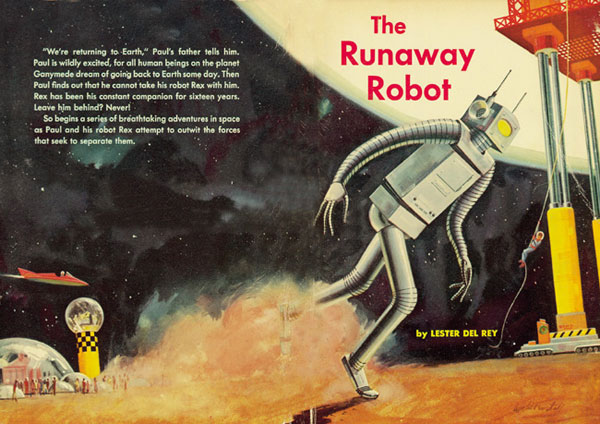
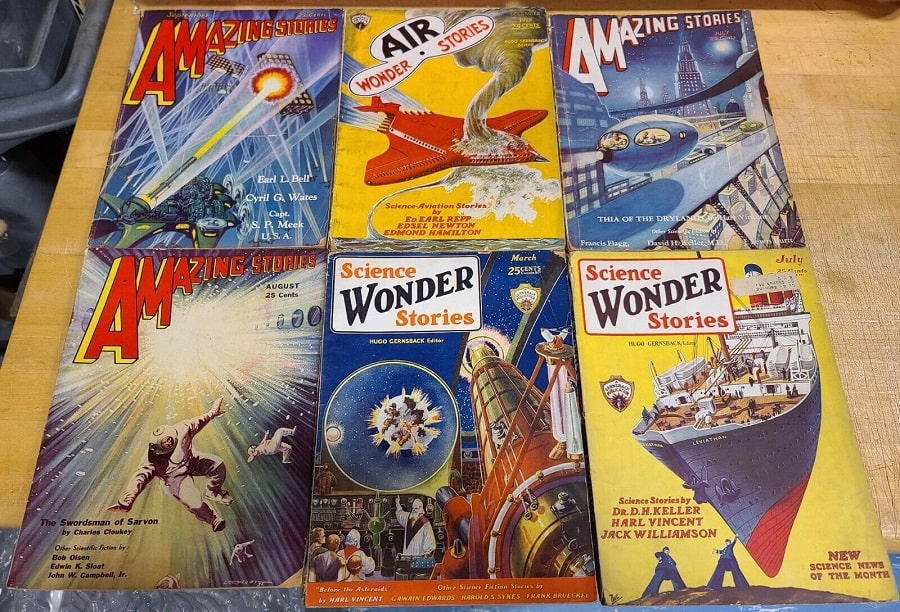
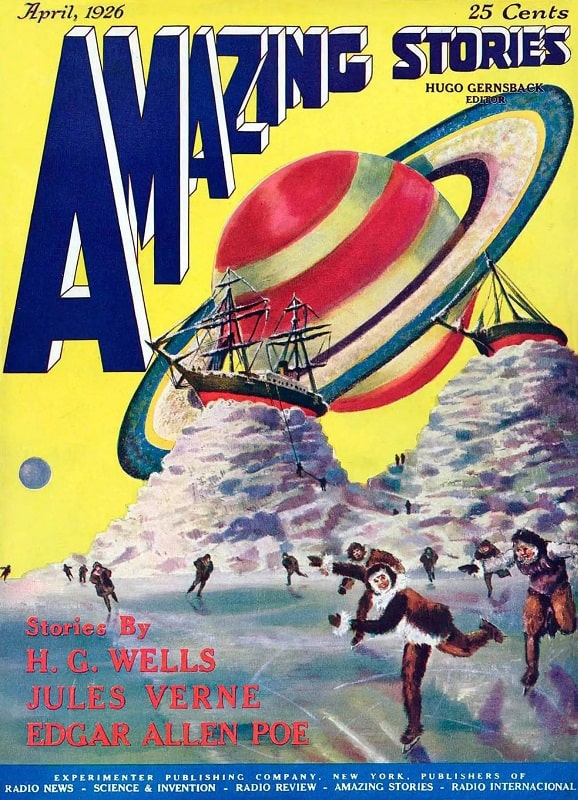

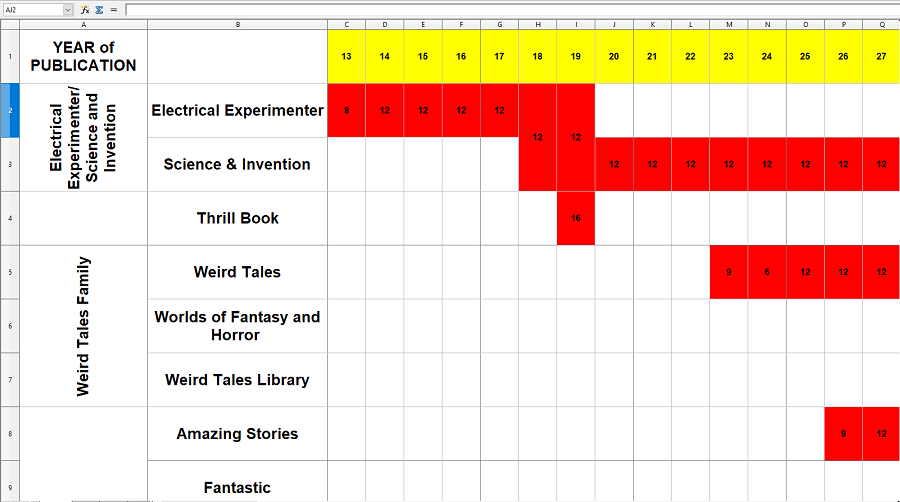
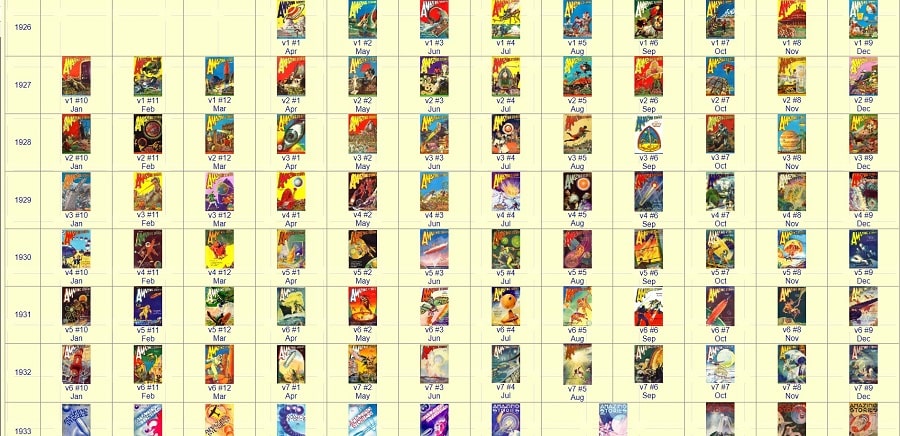
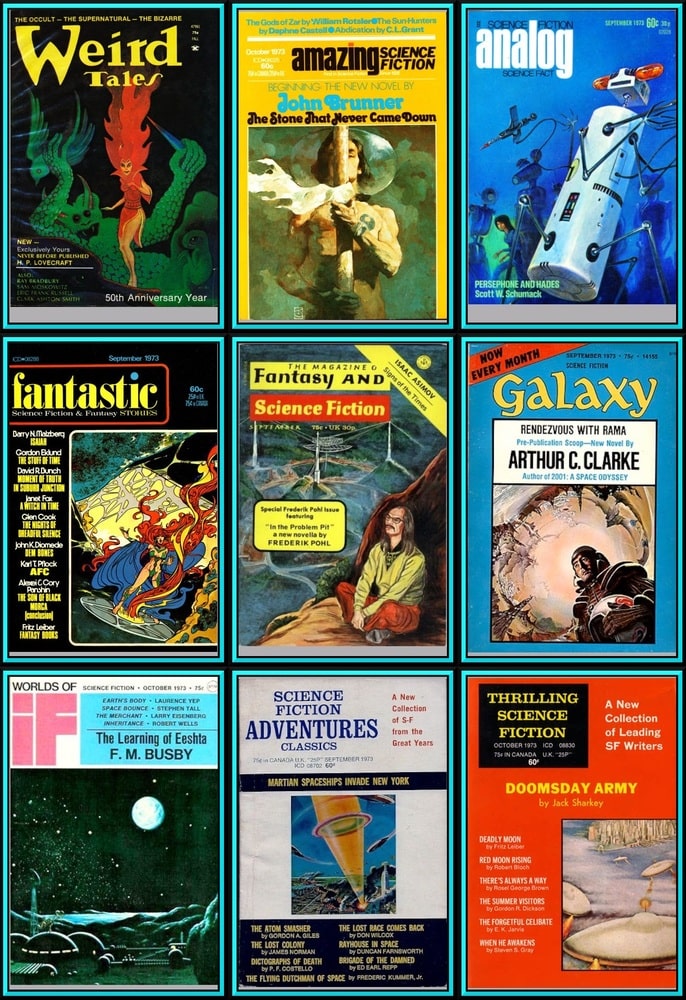
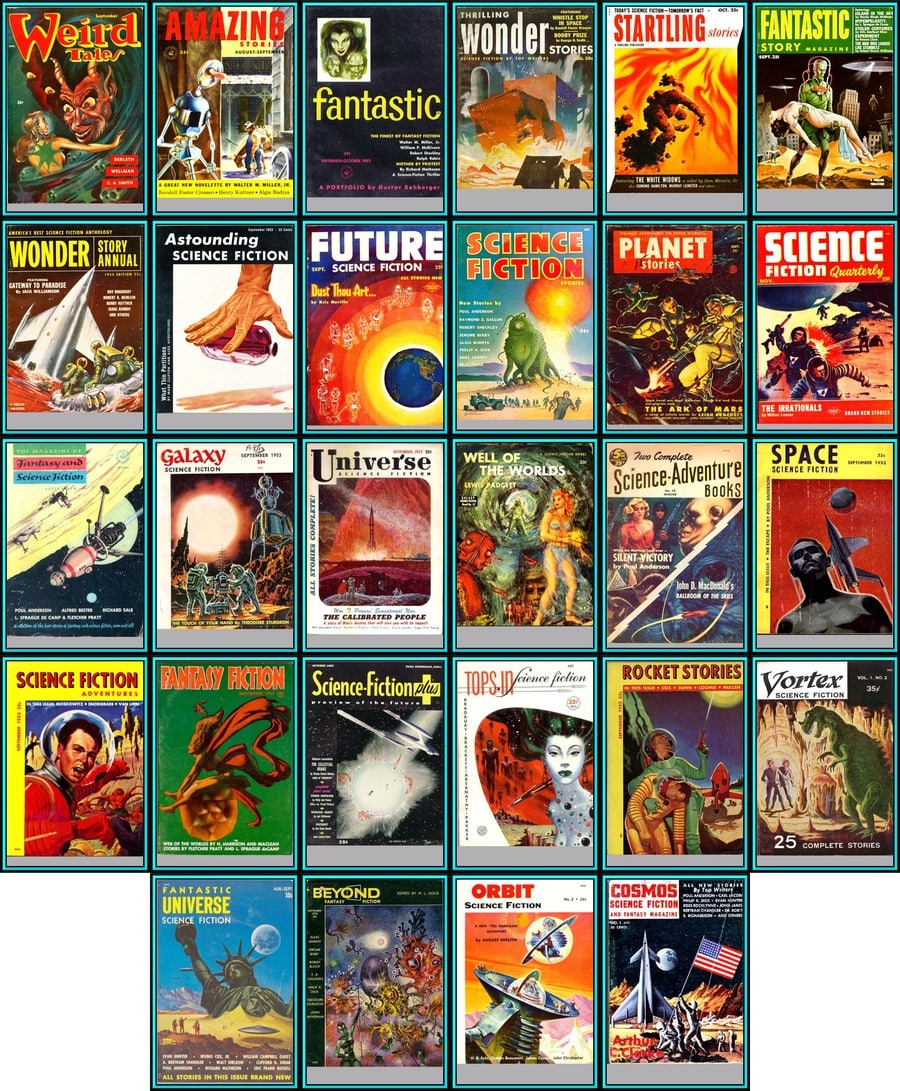
Marvelous, takes me back! You and I are of an age, sir.
The Runaway Robot was the only book I ever tried to order from Scholastic Books when I was in grade school, and three times it was publisher out of stock and my money was refunded.
I only got a copy of the book a few years ago…
Apparently, The Runaway Robot, was a gateway drug for a lot of us.
Steve,
It sure was for me. It was one of the first books I ordered from Scholastic, and I read it to pieces. I gave it to both of my sons when they were old enough, and they read it as well. I hope some day to read it to my grandsons!
[…] me to write up something a bit more formal for that publication and, as you can see if you visit Science Fiction History Considered As A Series Of Images Of Newsstand Displays, you’ll see what I put […]
Back to the newsstand covers…I started getting the mags in the ’70s, so the picture of that decade you have contains all the issues I own except for the Weird Tales (never saw that on the newsstand). I bought them mostly from a cigar / newspaper store that was right next to my grandparent’s apartment building…those were great days…
Well, I definitely purchased that Weird Tales while living in south New Jersey. My memory is conflicted on exactly where, alternately suggesting that I got it at a used book and magazine dealer at the Pennsauken Mart in Pennsauken, NJ (now gone), or at the Walden Books at the Echelon Mall;. I’m leaning more towards the Mart, as the cover date roughly coincides with the dates I would have been there regularly. I also picked up the Summer, 1973 issue at the same time.
Weird Tales always seems to have dealt with distribution issues, so I’m not surprised these issues were not seen by a lot of folks.
I remember sf/f magazines as being scarce on the ground in my early reading years (1960s/70s), so seeing the actual issues for 1963 and 1973 humbles me in my ignorance of the riches that I did not discover when they were available. And my guess for first woman editor in sf/f would have been Cele Goldsmith Lalli, who took over Amazing Stories in 1958. Thank you, Mr. Davidson, for opening my eyes a bit wider!
Note: the link on the 2nd panorama illustration (1933-2013) leads to the tribute to R. K. Robinson (April 2023) and not the illustration (to which the top copy does lead: “Science-Fiction-Magazines-1933-2013-min-1.jpg”)